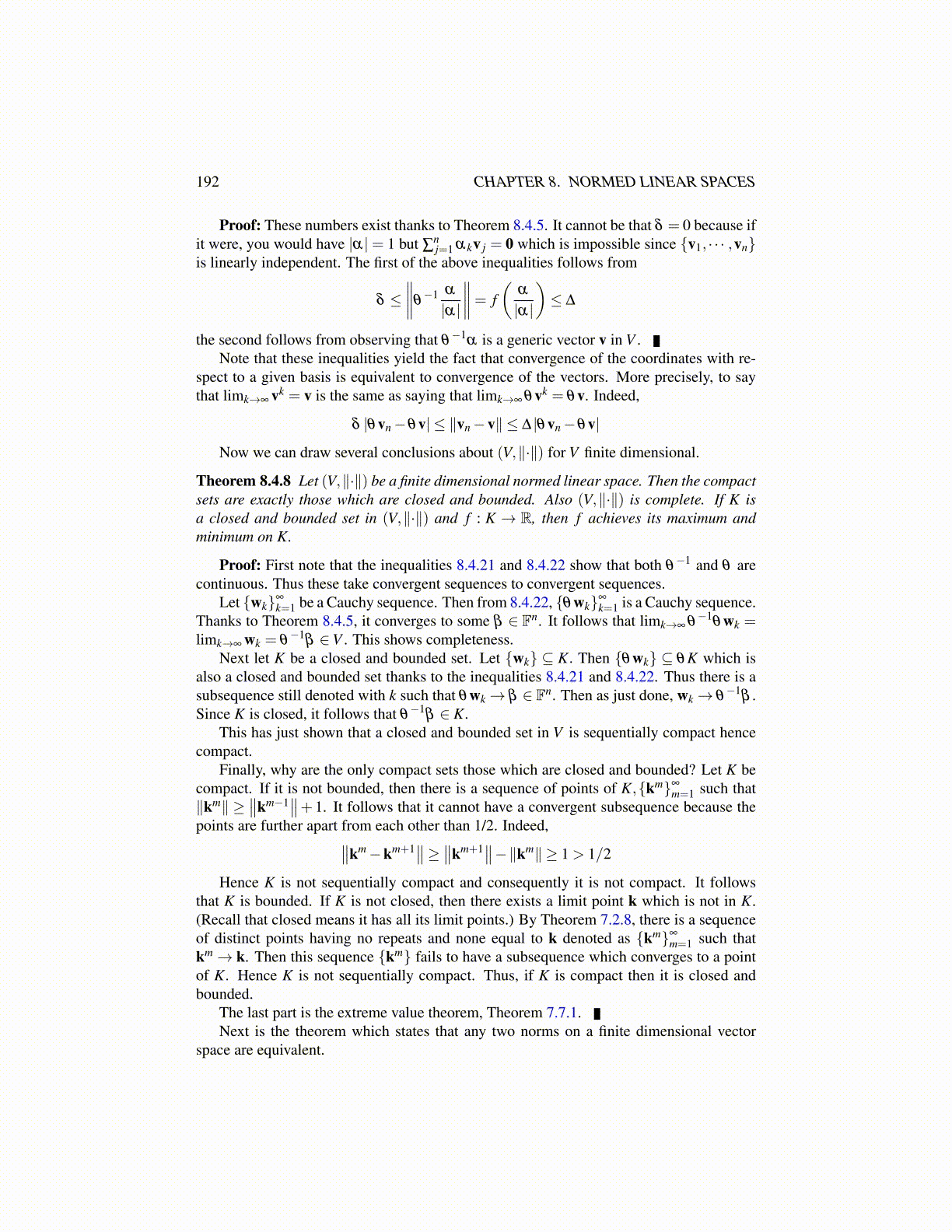
192 CHAPTER 8. NORMED LINEAR SPACES
Proof: These numbers exist thanks to Theorem 8.4.5. It cannot be that δ = 0 because ifit were, you would have |α|= 1 but ∑
nj=1 αkv j = 0 which is impossible since {v1, · · · ,vn}
is linearly independent. The first of the above inequalities follows from
δ ≤∥∥∥∥θ−1 α
|α|
∥∥∥∥= f(
α
|α|
)≤ ∆
the second follows from observing that θ−1
α is a generic vector v in V .Note that these inequalities yield the fact that convergence of the coordinates with re-
spect to a given basis is equivalent to convergence of the vectors. More precisely, to saythat limk→∞ vk = v is the same as saying that limk→∞ θvk = θv. Indeed,
δ |θvn−θv| ≤ ∥vn−v∥ ≤ ∆ |θvn−θv|
Now we can draw several conclusions about (V,∥·∥) for V finite dimensional.
Theorem 8.4.8 Let (V,∥·∥) be a finite dimensional normed linear space. Then the compactsets are exactly those which are closed and bounded. Also (V,∥·∥) is complete. If K isa closed and bounded set in (V,∥·∥) and f : K → R, then f achieves its maximum andminimum on K.
Proof: First note that the inequalities 8.4.21 and 8.4.22 show that both θ−1 and θ are
continuous. Thus these take convergent sequences to convergent sequences.Let {wk}∞
k=1 be a Cauchy sequence. Then from 8.4.22, {θwk}∞
k=1 is a Cauchy sequence.Thanks to Theorem 8.4.5, it converges to some β ∈ Fn. It follows that limk→∞ θ
−1θwk =
limk→∞ wk = θ−1
β ∈V . This shows completeness.Next let K be a closed and bounded set. Let {wk} ⊆ K. Then {θwk} ⊆ θK which is
also a closed and bounded set thanks to the inequalities 8.4.21 and 8.4.22. Thus there is asubsequence still denoted with k such that θwk→ β ∈ Fn. Then as just done, wk→ θ
−1β .
Since K is closed, it follows that θ−1
β ∈ K.This has just shown that a closed and bounded set in V is sequentially compact hence
compact.Finally, why are the only compact sets those which are closed and bounded? Let K be
compact. If it is not bounded, then there is a sequence of points of K,{km}∞
m=1 such that∥km∥ ≥
∥∥km−1∥∥+ 1. It follows that it cannot have a convergent subsequence because the
points are further apart from each other than 1/2. Indeed,∥∥km−km+1∥∥≥ ∥∥km+1∥∥−∥km∥ ≥ 1 > 1/2
Hence K is not sequentially compact and consequently it is not compact. It followsthat K is bounded. If K is not closed, then there exists a limit point k which is not in K.(Recall that closed means it has all its limit points.) By Theorem 7.2.8, there is a sequenceof distinct points having no repeats and none equal to k denoted as {km}∞
m=1 such thatkm→ k. Then this sequence {km} fails to have a subsequence which converges to a pointof K. Hence K is not sequentially compact. Thus, if K is compact then it is closed andbounded.
The last part is the extreme value theorem, Theorem 7.7.1.Next is the theorem which states that any two norms on a finite dimensional vector
space are equivalent.